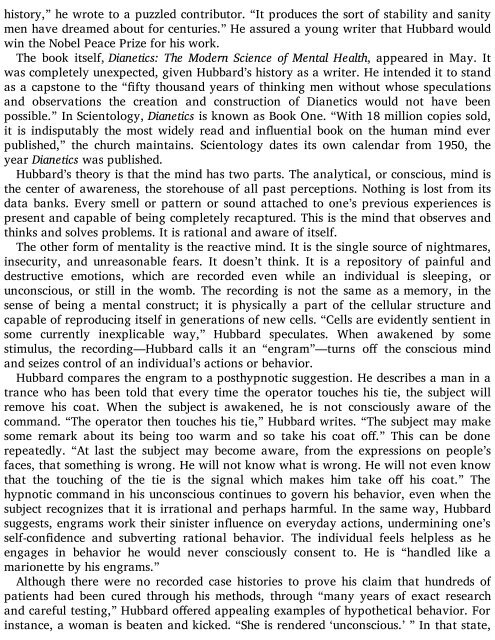going-clear-scientology-hollywood-and-the-prison-of-belief-by-lawrence-wright-2
going-clear-scientology-hollywood-and-the-prison-of-belief-by-lawrence-wright-2
going-clear-scientology-hollywood-and-the-prison-of-belief-by-lawrence-wright-2
You also want an ePaper? Increase the reach of your titles
YUMPU automatically turns print PDFs into web optimized ePapers that Google loves.
history,” he wrote to a puzzled contributor. “It produces <strong>the</strong> sort <strong>of</strong> stability <strong>and</strong> sanity<br />
men have dreamed about for centuries.” He assured a young writer that Hubbard would<br />
win <strong>the</strong> Nobel Peace Prize for his work.<br />
The book itself, Dianetics: The Modern Science <strong>of</strong> Mental Health, appeared in May. It<br />
was completely unexpected, given Hubbard’s history as a writer. He intended it to st<strong>and</strong><br />
as a capstone to <strong>the</strong> “fty thous<strong>and</strong> years <strong>of</strong> thinking men without whose speculations<br />
<strong>and</strong> observations <strong>the</strong> creation <strong>and</strong> construction <strong>of</strong> Dianetics would not have been<br />
possible.” In Scientology, Dianetics is known as Book One. “With 18 million copies sold,<br />
it is indisputably <strong>the</strong> most widely read <strong>and</strong> inuential book on <strong>the</strong> human mind ever<br />
published,” <strong>the</strong> church maintains. Scientology dates its own calendar from 1950, <strong>the</strong><br />
year Dianetics was published.<br />
Hubbard’s <strong>the</strong>ory is that <strong>the</strong> mind has two parts. The analytical, or conscious, mind is<br />
<strong>the</strong> center <strong>of</strong> awareness, <strong>the</strong> storehouse <strong>of</strong> all past perceptions. Nothing is lost from its<br />
data banks. Every smell or pattern or sound attached to one’s previous experiences is<br />
present <strong>and</strong> capable <strong>of</strong> being completely recaptured. This is <strong>the</strong> mind that observes <strong>and</strong><br />
thinks <strong>and</strong> solves problems. It is rational <strong>and</strong> aware <strong>of</strong> itself.<br />
The o<strong>the</strong>r form <strong>of</strong> mentality is <strong>the</strong> reactive mind. It is <strong>the</strong> single source <strong>of</strong> nightmares,<br />
insecurity, <strong>and</strong> unreasonable fears. It doesn’t think. It is a repository <strong>of</strong> painful <strong>and</strong><br />
destructive emotions, which are recorded even while an individual is sleeping, or<br />
unconscious, or still in <strong>the</strong> womb. The recording is not <strong>the</strong> same as a memory, in <strong>the</strong><br />
sense <strong>of</strong> being a mental construct; it is physically a part <strong>of</strong> <strong>the</strong> cellular structure <strong>and</strong><br />
capable <strong>of</strong> reproducing itself in generations <strong>of</strong> new cells. “Cells are evidently sentient in<br />
some currently inexplicable way,” Hubbard speculates. When awakened <strong>by</strong> some<br />
stimulus, <strong>the</strong> recording—Hubbard calls it an “engram”—turns o <strong>the</strong> conscious mind<br />
<strong>and</strong> seizes control <strong>of</strong> an individual’s actions or behavior.<br />
Hubbard compares <strong>the</strong> engram to a posthypnotic suggestion. He describes a man in a<br />
trance who has been told that every time <strong>the</strong> operator touches his tie, <strong>the</strong> subject will<br />
remove his coat. When <strong>the</strong> subject is awakened, he is not consciously aware <strong>of</strong> <strong>the</strong><br />
comm<strong>and</strong>. “The operator <strong>the</strong>n touches his tie,” Hubbard writes. “The subject may make<br />
some remark about its being too warm <strong>and</strong> so take his coat o.” This can be done<br />
repeatedly. “At last <strong>the</strong> subject may become aware, from <strong>the</strong> expressions on people’s<br />
faces, that something is wrong. He will not know what is wrong. He will not even know<br />
that <strong>the</strong> touching <strong>of</strong> <strong>the</strong> tie is <strong>the</strong> signal which makes him take o his coat.” The<br />
hypnotic comm<strong>and</strong> in his unconscious continues to govern his behavior, even when <strong>the</strong><br />
subject recognizes that it is irrational <strong>and</strong> perhaps harmful. In <strong>the</strong> same way, Hubbard<br />
suggests, engrams work <strong>the</strong>ir sinister inuence on everyday actions, undermining one’s<br />
self-condence <strong>and</strong> subverting rational behavior. The individual feels helpless as he<br />
engages in behavior he would never consciously consent to. He is “h<strong>and</strong>led like a<br />
marionette <strong>by</strong> his engrams.”<br />
Although <strong>the</strong>re were no recorded case histories to prove his claim that hundreds <strong>of</strong><br />
patients had been cured through his methods, through “many years <strong>of</strong> exact research<br />
<strong>and</strong> careful testing,” Hubbard oered appealing examples <strong>of</strong> hypo<strong>the</strong>tical behavior. For<br />
instance, a woman is beaten <strong>and</strong> kicked. “She is rendered ‘unconscious.’ ” In that state,


